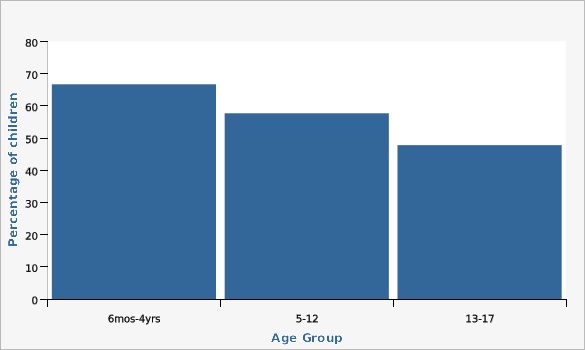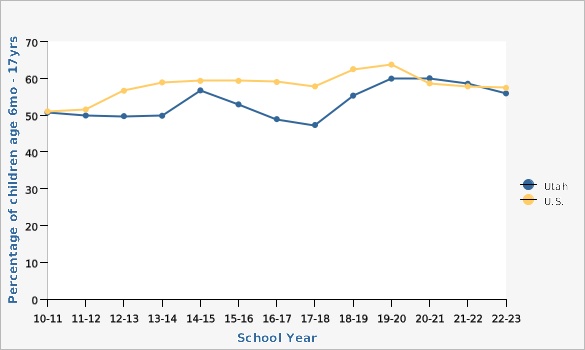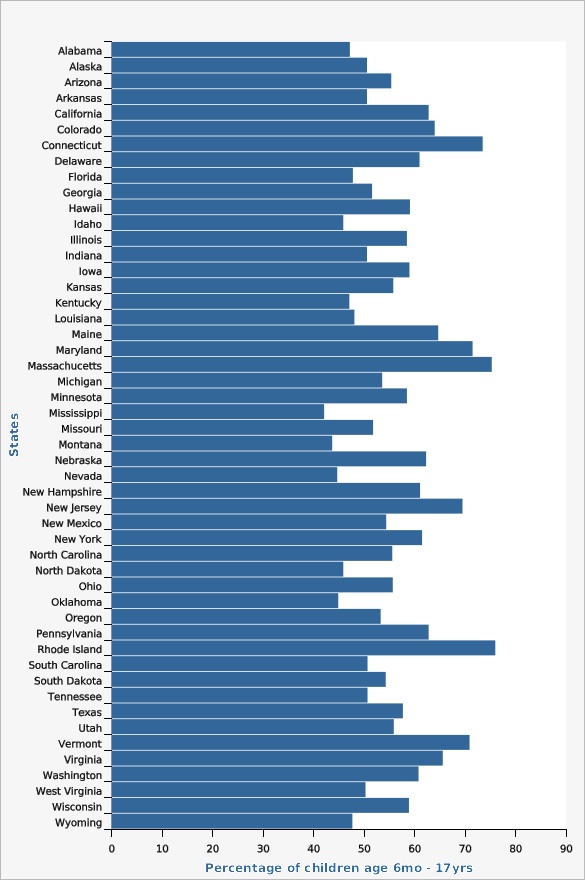Complete Health Indicator Report of Immunizations - Influenza, children and teens
Definition
Number of children who are reported to have received an influenza vaccination in the past 12 months.Numerator
Number of survey respondents who reported receiving an influenza vaccination in the past 12 months.Denominator
Number of survey respondents.Data Interpretation Issues
The National Immunization Survey (NIS) is conducted by the Centers for Disease Control and Prevention (CDC) and uses a random-digit-dialing sample of landline and cellular telephone numbers to find households throughout the U.S. children 19-35 months and teens 13-17 years, and flu vaccinations for children 6 months-17 years to participate in the survey. The NIS provides current, population-based, state and local area estimates of vaccination coverage among children and teens using a standard survey methodology. The survey collects data through telephone interviews with parents or guardians in all 50 states, the District of Columbia, and some U.S. territories. A short flu vaccination questionnaire, the National Immunization Survey-Child Influenza Module (NIS-CIM), is conducted from October through June each year for children 6-18 months and 3-12 years. Parents and guardians are asked if their children had a flu vaccination and, if so, in which month and year. If the child received a vaccination, respondents are asked how many vaccine doses the child received and whether it was a flu shot or a flu nasal spray. Additional questions about flu vaccination are also asked. Influenza immunization data for Utah and U.S. is also available from the FluVaxView Influenza Vaccination Coverage web page [https://www.cdc.gov/flu/fluvaxview/index.htm], which is estimated annually by CDC utilizing data from several nationally representative surveys.Why Is This Important?
Influenza, or flu, is an acute viral infection involving the respiratory tract that can occur in epidemics or pandemics. Influenza can cause a person, especially older persons, to be more susceptible to bacterial pneumonia. Children younger than five years old, especially those younger than two, are at high risk of developing serious flu-related complications. CDC estimates that between 6,000 and 26,000 children younger than five years have been hospitalized each year in the United States because of influenza. The flu vaccine is safe and helps protect children from flu.^1^ A guide for parents about Flu is available here: [https://www.cdc.gov/flu/pdf/freeresources/family/flu-information-for-parents-activity-sheet.pdf] __Reference__ #Centers for Disease Control and Prevention (CDC). ''The Flu: A Guide for Parents''. Retrieved from: [https://www.cdc.gov/flu/pdf/freeresources/family/flu-guide-for-parents-2018.pdf]Other Objectives
[[br]] ===Healthy People 2030 related objectives:=== IID-09: Increase the proportion of people who get the flu vaccine every year[[br]] '''U.S. Target:''' 70.0 percent [[br]]How Are We Doing?
Prior to the 2020/21 flu season, Utah's pediatric influenza immunization rate consistently fell below the national rate. In flu seasons 2010/11 thru 2013/2014 the Utah pediatric influenza immunization rate remained fairly static around 50%. In 2014/15 the rate increased to 56.7%. This was followed decreasing influenza immunization rates in the next three flu seasons. Utah's average pediatric influenza immunization rate for flu seasons 2015/16 - 2019/20 in Utah was 53.0%. Whereas the same measure for the U.S. was 60.5%. In the 2020/21 and 2021/22 flu seasons, however, Utah's pediatric flu vaccination rate was higher than the previous 10 flu seasons at 59.9% and 60.0%, respectively, and exceeded the national rate by small margin. In the 2022/23 season, Utah's rate decreased to 55.9%.How Do We Compare With the U.S.?
In Utah, 55.9% of children aged 6 months - 17 years surveyed on the National Immunization Survey (NIS) reported receiving a flu shot in the 2022/23 flu season. Nationwide for the same age group, the rate was 57.4%, about the same as the prior flu season.What Is Being Done?
The DHHS Immunization Program and Bureau of Epidemiology educate health care providers, clinic staff, and the public about prevention methods and support investigation of outbreaks. ==Who Should Get Influenza Vaccine?== For the 2023/24 flu season, the Advisory Committee on Immunization Practices (ACIP) recommends annual influenza vaccination for everyone six months and older with any licensed, appropriate influenza vaccine with no preference expressed for any one vaccine over another. Some vaccines are not recommended in some situations and health conditions, and some people should not receive influenza vaccines at all (though this is uncommon). ===The Influenza (Flu) Shot=== ====People who can get the flu shot:==== *Different flu shots are approved for people of different ages. Everyone should get a vaccine that is appropriate for their age. *There are inactivated influenza vaccines that are approved for people as young as six months of age. *Some vaccines are only approved for adults. *Flu shots are recommended for pregnant women and people with chronic health conditions. *Most people with egg allergy can get a flu shot. [[br]] ====People who SHOULD NOT get the flu shot:==== *Children younger than six months of age are too young to get the flu shot. *People with severe, life-threatening allergies to flu vaccine or any ingredient in the vaccine. This might include gelatin, antibiotics, or other ingredients. [[br]] ====People who should talk to their doctor before getting the flu shot:==== If you have one of the following conditions, talk with your healthcare provider: *If you have an allergy to any of the ingredients in the vaccine. Talk to your doctor about your allergy. *If you ever had Guillain-Barr Syndrome (a severe paralyzing illness, also called GBS). Some people with a history of GBS should not get this vaccine. Talk to your doctor about your GBS history. *If you are not feeling well, talk to your doctor about your symptoms. [[br]] ===Nasal Spray Flu Vaccine=== ====People who can get the nasal spray flu vaccine:==== *The nasal spray vaccine is approved for use in healthy non-pregnant individuals, 2 years through 49 years of age. [[br]] ====People who SHOULD NOT get the nasal spray vaccine:==== *Children younger than two years *Adults 50 years and older *Pregnant women *People with a history of severe allergic reaction to any component of the vaccine or to a previous dose of any influenza vaccine *Children 2 years through 17 years of age who are receiving aspirin- or salicylate- containing medications *People who are immunocompromised *Children 2 years through 4 years who have asthma or who have had a history of wheezing in the past 12 months *People who have taken influenza antiviral drugs within the previous 48 hours *People who care for severely immunocompromised persons (or otherwise avoid contact with those persons for 7 days after getting the nasal spray vaccine). *People who have taken influenza antiviral drugs within the previous 48 hours. [[br]] ====People who should talk to their healthcare provider:==== If you have one of the following conditions, talk with your healthcare provider. He or she can help decide whether vaccination is right for you, and then select the best vaccine for you situation: *People with asthma aged 5 years and older *People with underlying medical conditions that can put them at higher risk of serious flu complications. These include conditions such as chronic lung diseases, heart disease, kidney disease, liver disorders, neurological and neuromuscular disorders, blood disorders, or metabolic disorders. *People with moderate or severe acute illness with or without fever *People with Guillain-Barr Syndrome within 6 weeks following a previous dose of influenza vaccine. [[br]] __Reference__[[br]] Centers for Disease Control and Prevention (CDC). "Who Should and Who Should NOT get a Flu Vaccine". Retrieved from: [https://www.cdc.gov/flu/prevent/whoshouldvax.htm].Available Services
Influenza vaccine is often covered by medical insurance. For patients that need assistance paying for influenza vaccine, the Vaccines for Children (VFC) program may be able to help. Information on the VFC program can be found at [https://immunize.utah.gov/vaccines-for-children-program/]. Call the Immunization Hotline at 1-800-275-0659 for a list of Community Health Clinics, County Health Departments, and other providers who can assist you. Additionally, information about influenza vaccinations can be found on the Utah Immunization Program website at: [https://immunize.utah.gov/].Related Indicators
Related Relevant Population Characteristics Indicators:
Related Health Care System Factors Indicators:
Related Risk Factors Indicators:
Related Health Status Outcomes Indicators:
Graphical Data Views
| Age Group | Percentage of children | Lower Limit | Upper Limit | |||
|---|---|---|---|---|---|---|
Record Count: 3 | ||||||
| 6mos-4yrs | 66.7% | 60.2% | 73.2% | |||
| 5-12 | 57.7% | 52.4% | 63.0% | |||
| 13-17 | 47.8% | 41.9% | 53.7% | |||
Data Source
National Immunization Survey, National Center for Health Statistics, U.S. Centers for Disease Control and Prevention| Utah vs. U.S. | School Year | Percentage of children age 6mo - 17yrs | Lower Limit | Upper Limit | ||
|---|---|---|---|---|---|---|
Record Count: 26 | ||||||
| Utah | 10-11 | 50.7% | 44.6% | 56.8% | ||
| Utah | 11-12 | 49.9% | 44.0% | 55.8% | ||
| Utah | 12-13 | 49.7% | 45.2% | 54.2% | ||
| Utah | 13-14 | 49.8% | 45.9% | 53.7% | ||
| Utah | 14-15 | 56.7% | 51.4% | 62.0% | ||
| Utah | 15-16 | 52.9% | 49.0% | 56.8% | ||
| Utah | 16-17 | 48.9% | 44.4% | 53.4% | ||
| Utah | 17-18 | 47.3% | 43.6% | 51.0% | ||
| Utah | 18-19 | 55.3% | 51.5% | 59.1% | ||
| Utah | 19-20 | 59.9% | 56.0% | 63.8% | ||
| Utah | 20-21 | 60.0% | 56.0% | 64.0% | ||
| Utah | 21-22 | 58.5% | 54.5% | 62.5% | ||
| Utah | 22-23 | 55.9% | 52.3% | 59.5% | ||
| U.S. | 10-11 | 51.0% | 50.1% | 51.9% | ||
| U.S. | 11-12 | 51.5% | 50.5% | 52.5% | ||
| U.S. | 12-13 | 56.6% | 55.7% | 57.5% | ||
| U.S. | 13-14 | 58.9% | 58.1% | 59.7% | ||
| U.S. | 14-15 | 59.3% | 58.5% | 60.1% | ||
| U.S. | 15-16 | 59.3% | 58.5% | 60.1% | ||
| U.S. | 16-17 | 59.0% | 58.3% | 59.7% | ||
| U.S. | 17-18 | 57.8% | 57.1% | 58.5% | ||
| U.S. | 18-19 | 62.5% | 61.8% | 63.2% | ||
| U.S. | 19-20 | 63.7% | 63.1% | 64.3% | ||
| U.S. | 20-21 | 58.6% | 58.0% | 59.2% | ||
| U.S. | 21-22 | 57.8% | 57.3% | 58.3% | ||
| U.S. | 22-23 | 57.4% | 56.8% | 58.0% | ||
Data Source
National Immunization Survey, National Center for Health Statistics, U.S. Centers for Disease Control and Prevention| States | Percentage of children age 6mo - 17yrs | Lower Limit | Upper Limit | |||
|---|---|---|---|---|---|---|
Record Count: 50 | ||||||
| Alabama | 47.2% | 43.9% | 50.5% | |||
| Alaska | 50.6% | 45.1% | 56.1% | |||
| Arizona | 55.4% | 51.6% | 59.2% | |||
| Arkansas | 50.6% | 47.4% | 53.8% | |||
| California | 62.8% | 60.3% | 65.3% | |||
| Colorado | 64.0% | 61.3% | 66.7% | |||
| Connecticut | 73.5% | 69.5% | 77.5% | |||
| Delaware | 61.0% | 56.3% | 65.7% | |||
| Florida | 47.8% | 44.8% | 50.8% | |||
| Georgia | 51.6% | 48.2% | 55.0% | |||
| Hawaii | 59.1% | 54.8% | 63.4% | |||
| Idaho | 45.9% | 41.2% | 50.6% | |||
| Illinois | 58.5% | 56.1% | 60.9% | |||
| Indiana | 50.6% | 47.2% | 54.0% | |||
| Iowa | 59.0% | 55.0% | 63.0% | |||
| Kansas | 55.8% | 52.6% | 59.0% | |||
| Kentucky | 47.1% | 43.3% | 50.9% | |||
| Louisiana | 48.1% | 45.3% | 50.9% | |||
| Maine | 64.7% | 60.7% | 68.7% | |||
| Maryland | 71.5% | 68.8% | 74.2% | |||
| Massachucetts | 75.3% | 72.6% | 78.0% | |||
| Michigan | 53.6% | 50.5% | 56.7% | |||
| Minnesota | 58.5% | 55.2% | 61.8% | |||
| Mississippi | 42.1% | 37.8% | 46.4% | |||
| Missouri | 51.8% | 48.6% | 55.0% | |||
| Montana | 43.7% | 39.7% | 47.7% | |||
| Nebraska | 62.3% | 58.2% | 66.4% | |||
| Nevada | 44.7% | 40.6% | 48.8% | |||
| New Hampshire | 61.1% | 57.0% | 65.2% | |||
| New Jersey | 69.5% | 66.3% | 72.7% | |||
| New Mexico | 54.4% | 50.7% | 58.1% | |||
| New York | 61.5% | 59.1% | 63.9% | |||
| North Carolina | 55.6% | 52.5% | 58.7% | |||
| North Dakota | 45.9% | 41.2% | 50.6% | |||
| Ohio | 55.7% | 52.2% | 59.2% | |||
| Oklahoma | 44.9% | 41.6% | 48.2% | |||
| Oregon | 53.3% | 49.4% | 57.2% | |||
| Pennsylvania | 62.8% | 60.6% | 65.0% | |||
| Rhode Island | 76.0% | 71.6% | 80.4% | |||
| South Carolina | 50.7% | 47.3% | 54.1% | |||
| South Dakota | 54.3% | 49.7% | 58.9% | |||
| Tennessee | 50.7% | 46.9% | 54.5% | |||
| Texas | 57.7% | 55.7% | 59.7% | |||
| Utah | 55.9% | 52.3% | 59.5% | |||
| Vermont | 70.9% | 66.3% | 75.5% | |||
| Virginia | 65.6% | 63.1% | 68.1% | |||
| Washington | 60.8% | 57.2% | 64.4% | |||
| West Virginia | 50.3% | 46.5% | 54.1% | |||
| Wisconsin | 58.9% | 55.4% | 62.4% | |||
| Wyoming | 47.7% | 42.7% | 52.7% | |||
Data Source
National Immunization Survey, National Center for Health Statistics, U.S. Centers for Disease Control and PreventionReferences and Community Resources
More information on the National Immunization Survey and the National Immunization Survey-Child Influenza Module may be found on the website of the Centers for Disease Control and Prevention - [https://www.cdc.gov/vaccines/imz-managers/nis/about.html]. To find clinics that provide flu vaccine in your community, please utilize the HealthMap Vaccine Finder at: [https://www.vaccines.gov/find-vaccines/].More Resources and Links
Evidence-based community health improvement ideas and interventions may be found at the following sites:- Centers for Disease Control and Prevention (CDC) WONDER Database, a system for disseminating public health data and information.
- United States Census Bureau data dashboard.
- Utah healthy Places Index, evidence-based and peer-reviewed tool, supports efforts to prioritize equitable community investments, develop critical programs and policies across the state, and much more.
- County Health Rankings
- Kaiser Family Foundation's StateHealthFacts.org
- Medical literature can be queried at PubMed library.
Page Content Updated On 12/28/2023,
Published on 02/21/2024



